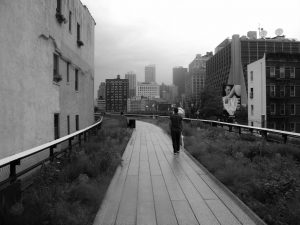How does a decrepit, abandoned elevated railroad viaduct in the middle of the meatpacking district of New York City transform itself and an entire neighborhood into the most visited site in Manhattan, with the most expensive zip code, and jump start a building construction boom to rival that of any time period in Gotham? Good zoning!
The West 30th Street Secondary Track, known as the Highline, was a 1.6 mile freight rail line constructed in the early 1930’s by the New York Central Railroad. It once hosted 40 trains a day and was called the “Lifeline of New York”. By the 1960’s, with the deindustrialization of Manhattan and the introduction of a modern highway system bringing trucks and displacing trains, the Highline’s heyday was past. Fast forward 30 years and real estate developers began suing the Highline’s owner Conrail, seeking to demolish the line to make room for gentrification and development. After years of litigation leading to a legal standoff between Conrail and the property owners, in stepped Mayor Michael Bloomberg and a local community group, the Friends of the Highline (FHL), to repurpose the Highline into a modern park and trail under the National Rails to Trails Program.

The key factor that allowed this remarkable transformation was the creation in 2005 of the Special Chelsea Zoning District, which allowed property owners a ten-fold increase in FAR (Floor Area Ratio) and the creation of bountiful TDRs (transfer development rights). These zoning changes were tantamount to injecting development steroids into what was once a run down, forgotten corner of the City. Suddenly, litigation was settled, $160M in government and private funding was raised, and, “voila”, the most significant development since the creation of Central Park rose like a phoenix during the middle of the recent recession. CSX – Conrail’s successor to the Highline – donated the line to New York City (occasioning a charitable “write off” of $100M), and by 2007 the first segment of the park was opened. At the same time, in order to protect against possible historic environmental liabilities, indemnities are secured by an innovative environmental insurance policy.
Meanwhile, the City and communities molded the zoning process to require affordable housing set asides, and to preserve sight lines and set-backs to maintain the unique, gritty, industrial feel of the neighborhood. The unlikely success of the Highline becomes a “win-win” for all of the stakeholders: the railroad, the property owners, the City and the community. Today, FHL manages and maintains the Highline with a staff of over 80 employees as a New York City Park. Over 7 million visitors a year have been attracted, and development has moved to the far west side of Manhattan. A proverbial avalanche of shops, restaurants and other hip establishments have sprung up along the Highline. And in a final irony, the property owner that sued the railroads for over 30 years ended up flipping less than an acre of property for over $800 million!
The two big questions going forward are whether the cost to maintain the Highline is sustainable and whether as a model, the Highline is replicable in other cities. The Center City District in Philadelphia has watched carefully and has taken significant steps to create a park on the abandoned Reading Viaduct north of Chinatown. Stay tuned to this space for that story.
Jonathon Broder is Vice President and Chief Legal Officer of Conrail and worked on the Highline matter from 1989 to the present.
